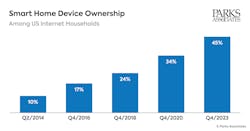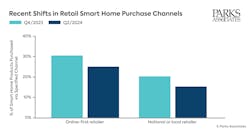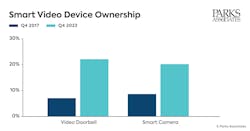This article originally appeared in the February 2025 issue of Security Business magazine. Feel free to share, and please don’t forget to mention Security Business magazine on LinkedIn and @SecBusinessMag on Twitter.
The Skinny:
-
AI Dominates Smart Homes: AI is being integrated into smart home devices; however, concerns about privacy and biased decision-making still exist.
-
Smart Home Hubs Making a Comeback: As fragmentation grows in smart home devices, hubs are being embedded into more products to provide unified ecosystem control.
-
Smart Lock Evolution: Smart locks are advancing with features like NFC and UWB technology for better security and convenience.
This year at CES, many new technologies emerged to make the connected home experience more valuable. More advanced “smarts” were unveiled in many smart home applications, including security, energy, controls, entertainment, and lighting.
As revealed at the annual Parks Associates Connections Summit at CES – an annual research and industry event featuring leaders from the broadband, security, smart home, consumer electronics, and connected health solution markets – major trends at CES included AI, hubs, smart home communications protocols, and safety and security solutions.
Here are our top five CES smart home trends:
1. AI is in everything. Artificial Intelligence is being integrated into consumer technologies, including smartphones and smart home devices like video doorbells. The AI enables intuitive, user-friendly experiences through edge and cloud processing, as well as generative and agentic AI.
Agentic AI is an artificial intelligence system that can act autonomously, make decisions, and perform tasks without continuous human intervention. It can take actions in the world based on its programming, inputs, and decision-making processes, much like an "agent" in a given environment.
Parks Associates data shows 26% of home security system owners or intenders desire video analytics to identify specific events, such as distinguishing between people, packages, or cars. Products like the Swann Xtreem4K wireless camera are examples of this trend, using AI for advanced facial recognition and motion analysis to reduce false alarms. The camera also responds to perceived threats by sending real-time alerts, recording, or using two-way audio to deter intruders.
Samsung’s "AI for All" initiative takes this further by embedding AI in its appliances to create personalized and efficient home experiences. Devices like TVs and fridges will act as sensors for the SmartThings platform, enabling seamless integration across the home. AI embedded at the chip level allows devices to process and adapt locally, reducing reliance on costly cloud computing and enabling real-time coordination. Smart home systems can learn occupant patterns, suggest routines, and optimize energy and water usage, providing practical benefits.
While AI promises to make smart homes “truly smart,” concerns remain. Parks Associates research shows 33% of households avoiding generative AI cite privacy concerns. Missteps in AI deployment, such as biased decision-making, could undermine consumer trust, making thoughtful implementation critical.
2. The smart home moves back to the hub. As the smart home expands beyond integrated systems to include devices as point solutions, more fragmentation has occurred, and consumers are not forced to use solutions requiring hubs or bridges. For example, multi-purpose devices like smart speakers are increasingly doubling as hubs.
Manufacturers are now embedding hub technology into devices to add value. At CES, LG introduced the second-generation LG SIGNATURE microwave, which integrates a hub for controlling LG ThinQ and Matter-enabled devices. Hubs operating at the edge, like Athom’s Homey Pro Mini, enhance security and processing speed. Aqara’s innovative wall hubs, such as the Panel Hub S1 Plus, further demonstrate the trend toward interactive and versatile smart home solutions.
Hubs are not currently a priority for today’s consumers – only 6% of device intenders see them as important – but the features they enable, such as ecosystem connectivity, are highly valued. For example, 56% of smart home intenders consider Alexa important as an ecosystem control platform, and 32% consider integration with security systems important. Consumers want simplicity, with 90% of smart home device owners favoring a single unified app to control their devices.
3. Matter is more relevant, but multi-protocol is the future. Updated protocols from the Thread Group and Connectivity Standards Alliance (CSA) are enhancing utility and desirability in connected homes. These protocols enable better coordination and instantaneous processing, preventing network slowdowns or timeouts.
Parks Associates research reveals that 40% of smart home device returns in the past year were due to the product not working with other owned devices. Matter – initially expected to resolve such challenges – has been slow to deliver but is making progress. Matter 1.4 allows modern routers to serve as Thread Border Routers, connecting Thread-enabled devices to the main Wi-Fi network. This enables seamless communication between Matter-compatible devices and services, addressing interoperability concerns.
The smart home ecosystem will continue to evolve in a multi-protocol world. Companies like Trident IoT and its partnership with Semtech are advancing this evolution by developing multi-protocol chips, addressing diverse use-cases, and making integration easier for smart home players.
4. This is the year of the smart lock. Currently, 9% of US internet households own a smart lock, making it a slowly growing category in the smart home market. The locks are a critical component of home security, but consumer trust remains a hurdle; in fact, Parks Associates data shows 65% of smart door lock owners are concerned about the security of these devices.
Manufacturers must address these concerns and market more aggressively to align consumer adoption with industry growth.
Historically, smart locks have been limited to phone apps and key codes for interaction; however, advancements in 2024 brought features like NFC technology and presence-sensing capabilities using ultra-wideband (UWB) technology. These enhancements allow locks to automatically lock or unlock doors based on proximity, offering both convenience and improved security. Read more about these locks here.
By 2025, NFC and UWB have become table stakes for smart lock manufacturers. To differentiate in this competitive market, manufacturers will need to innovate beyond these features, potentially integrating hub technology into the lock or expanding their applications beyond the front door to capture greater consumer interest.
5. Security devices have matured, but few have new features and applications. Smart home security devices focused on the perimeter have disrupted traditional pro-install, pro-monitored solutions – leading established players to adapt with tailored models, while new entrants emphasize DIY and self-monitoring options with optional paid services.
Security systems typically address intrusion with sensors and panels, while video doorbells and networked cameras dominate consumer adoption of individual point solutions. Parks Associates data shows ownership of video doorbells peaking at 22% of internet-connected households in Q3 2024, followed by 20% owning a smart camera, making them the two top-owned smart home devices.
To differentiate, manufacturers are moving beyond standard features, focusing on "whole-home" security that includes use-cases beyond the perimeter. At CES, Lockly Vision Prestige showcased a lock with an integrated camera, offering video feeds to enhance visibility and security. Pawport introduced a secure "pet tunnel" with dual doors for added protection.
Wi-Fi sensing technology is also gaining traction for both perimeter and in-home applications, particularly in caregiving solutions. Threshold’s Motion Wi-Fi Sensing Plug exemplifies this innovation, using Wi-Fi sensing to detect movement without relying on cameras or microphones, ensuring privacy. It integrates with existing networks to provide alerts or automate actions based on activity, offering a discreet and privacy-focused approach to home monitoring.
These advancements reflect the shift toward holistic smart home security solutions, emphasizing convenience, privacy, and adaptability to diverse applications.
2025 Smart Home Economic and Policy Outlook
The smart home ecosystem is becoming more integrated and responsive with technologies like AI-driven cameras and smarter home devices. Looking ahead to 2025, there are a few key economic and policy factors that may shape how these technologies are adopted by consumers.
Tariffs on imported goods – particularly tech products – could have an impact on pricing, potentially raising the cost of certain smart devices. It may also impact how consumers buy devices. Parks Associates research shows a small decline in online buying in Q2 2024, as more consumers purchase through manufacturers to receive discounts from bundling.
These economic and policy shifts could influence consumer spending as well, as higher prices might cause some to hold back on upgrading or purchasing new tech. As competition among manufacturers intensifies, we might see some price adjustments or alternative solutions that make these smart home innovations more accessible to a broader audience.
About the Author

Daniel Holcomb
Daniel Holcomb is Senior Analyst for Parks Associates, which covers the security and smart home market extensively within its research practice. The company will host the 20th annual CONNECTIONS SUMMIT at CES Jan. 7, 2026, and the 30th annual CONNECTIONS, The Premier Connected Home Conference, on May 5-7 in Santa Clara, Calif. Visit www.parksassociates.com to learn more.



